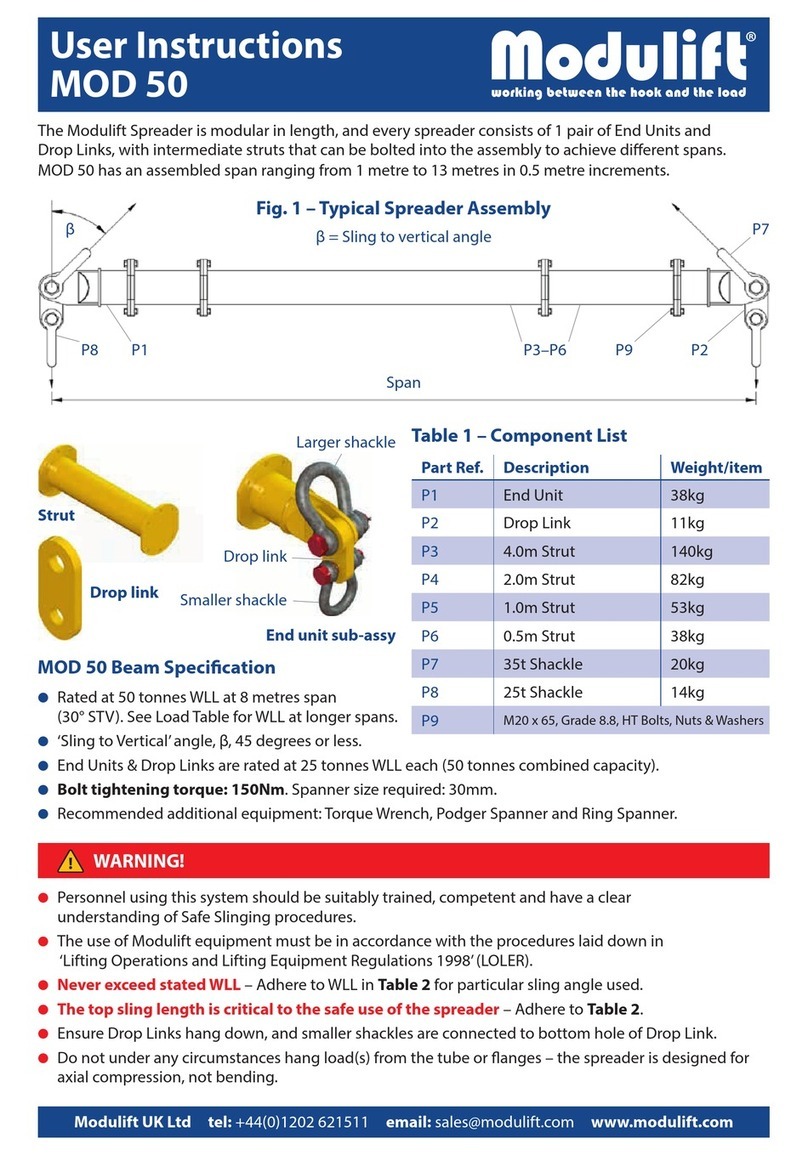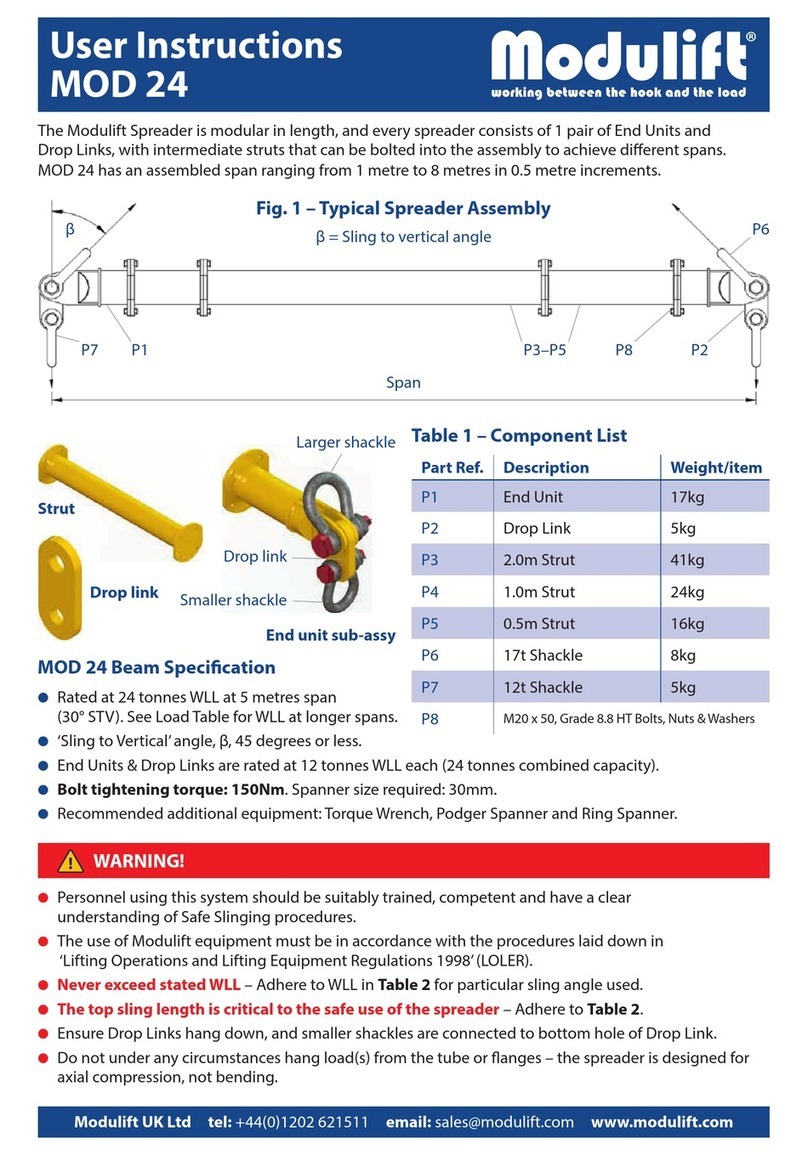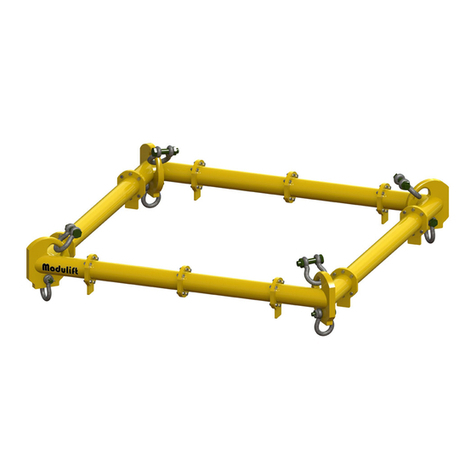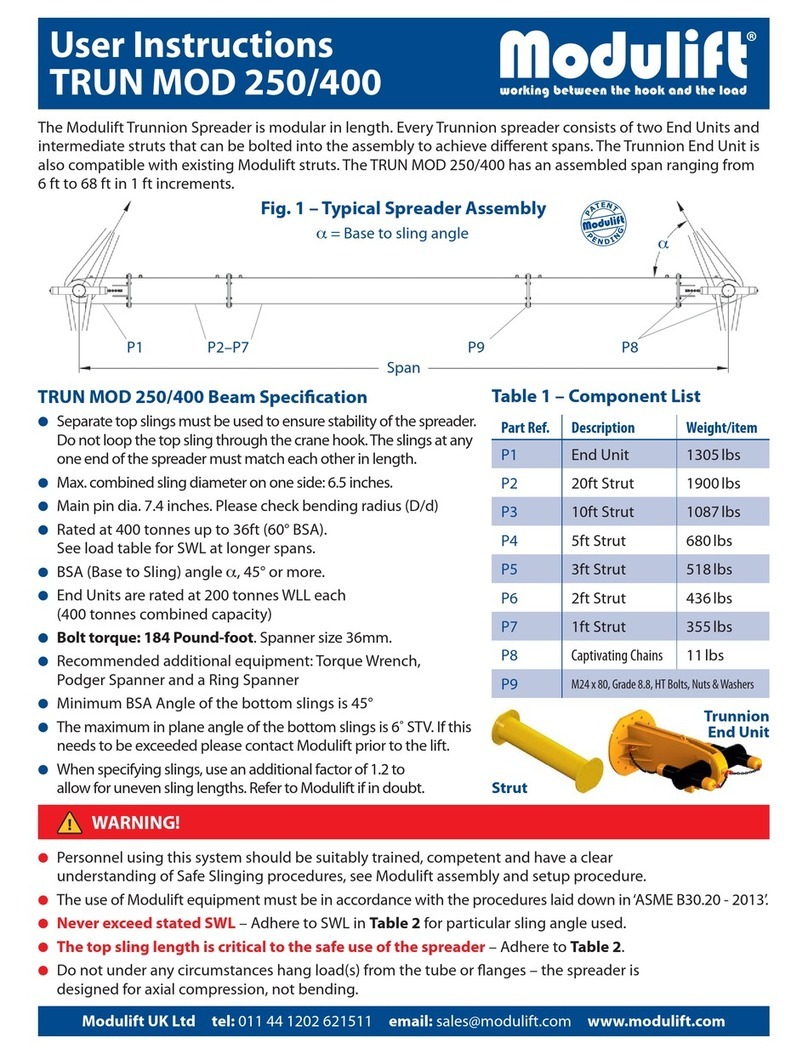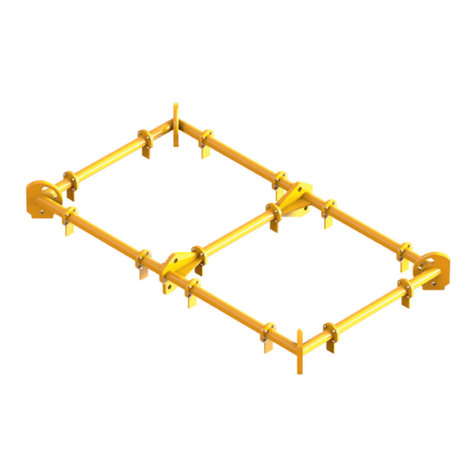
User Instructions
Should you nd your equipment is no longer of use,
please dispose of in a responsible manner. Please
contact Modulift if you need further guidance
Do’s & Don’ts
Do ensure to load the spreader through the drop links
only. i.e. adhere to Fig. 1.
Do keep the loaded spreader clear of obstacles
– any contact could cause beam failure.
Do ensure correct use of appropriate top slings, do not
twist any slings unnecessarily.
Do not hang any load from the spreader tube or anges.
Do not exceed stated WLL for that particular span
– adhere to Table 2.
Do not rig the lower slings more than 6 degrees from vertical.
When moving or positioning long struts or assemblies use
tag lines to control movement.
Individual components can be heavy and extreme care
must be taken if manual handling.
Table 2 – Load v Span
Recommended top sling types:
Textile slings, wire rope slings with soft eyes and chain slings
with small end ttings. If thimble eyes are used with wire rope
slings, make sure sling angle is 30 degrees or less. Other types
exist but not all are suitable due to end tting size, particularly
larger capacity chain hook and thimble eyes.
Note: Lengthening the slings can give greater clearance.
Refer to Modulift supplier if in doubt.
The rigger must ensure that there is a clearance
between the sling end tting and the end unit
as shown above.
Max number of struts allowed in spreader
assembly: 5.
Assemble longer struts in the centre of the
spreader conguration.
Sling angle is crucial to safe use of spreader.
WARNING!
© Copyright 2019 Modulift.
All rights reserved.
Assembly Procedure
Check the ID plates on each Modulift component to
ensure the correct size is used.
Lay out the Struts and End Units in the correct
conguration (see Table 2), laid on ats to prevent rolling.
Check that all pairs of anges are clear from debris, sand
etc. before connection.
Bolt the components together using bolts, nuts & washers
provided. Tighten the bolts to a torque as shown overleaf,
4 bolts per connection. The number and grade of bolts
is critical for the safe use of the spreader particularly at
longer spans.
Place drop link inside the jaw of an end unit, with the
larger hole of drop link lined up with the End Unit hole.
Place a top sling onto the body of a top shackle, and put
jaw of top shackle over the end unit jaw.
Put top shackle pin through shackle, end unit jaw and
drop link, and repeat for other spreader beam end.
Attach free ends of top slings to crane hook.
Attach lower slings and shackles to lower holes of drop
links, and attach them to the load to be lifted.
The assembled spreader beam and lifting rig must be
thoroughly checked by a competent person prior to lifting.
MOD 12
MOD 12 UK JAN 2019
Span
(m)
Sling To Vertical Angle (STV) β
Recommended Conguration
EU - End Unit (0.25m)
45° 30° 20°
WLL
(t)
Min.top
sling
length
(m)
WLL
(t)
Min.top
sling
length
(m)
WLL
(t)
Min.top
sling
length
(m)
0.50 12 0.3 12 0.4 12 0.7 EU EU
0.75 12 0.5 12 0.7 12 1.0 EU 0.25 EU
1.00 12 0.6 12 0.9 12 1.4 EU 0.5 EU
1.25 12 0.8 12 1.2 12 1.8 EU 0.75 EU
1.50 12 1 12 1.4 12 2.1 EU 1 EU
1.75 12 1.2 12 1.7 12 2.5 EU 1 0.25 EU
2.00 12 1.4 12 1.9 12 2.9 EU 1.5 EU
2.25 12 1.5 12 2.2 12 3.2 EU 1.5 0.25 EU
2.50 12 1.7 12 2.4 12 3.6 EU 1.5 0.5 EU
2.75 12 1.9 12 2.7 12 4.0 EU 1.5 0.75 EU
3.00 12 2.1 12 2.9 12 4.3 EU 1.5 1 EU
3.25 12 2.2 12 3.2 12 4.7 EU 1 1.5 0.25 EU
3.50 12 2.4 12 3.4 12 5.1 EU 1 1.5 0.5 EU
3.75 11 2.6 12 3.7 12 5.4 EU 1 1.5 0.75 EU
4.00 10 2.8 12 3.9 12 5.8 EU 1 1.5 0.75 0.25 EU
4.25 9 2.9 12 4.2 12 6.2 EU 1.5 1 1 0.25 EU
4.50 8 3.1 12 4.4 12 6.5 EU 1.5 1 1 0.5 EU
4.75 7 3.3 12 4.7 12 6.9 EU 1.5 1 1 0.75 EU
5.00 6 3.5 11 4.9 12 7.3 EU 1.5 1 1 1 EU
5.25 5 3.7 10 5.2 12 7.6 EU 1.5 1 1 1 0.25 EU
5.50 5 3.8 9 5.4 12 8.0 EU 1.5 1.5 1 1 EU
5.75 4 4 8 5.7 12 8.3 EU 1.5 1 1 1 0.75 EU
6.00 4 4.2 7 5.9 12 8.7 EU 1.5 1 1 1 1 EU
6.25 4 4.4 7 6.2 11 9.1 EU 1.5 1.5 1.5 1 0.25 EU
6.50 3 4.5 6 6.4 10 9.4 EU 1.5 1.5 1 1 1 EU
Clearance Clearance












